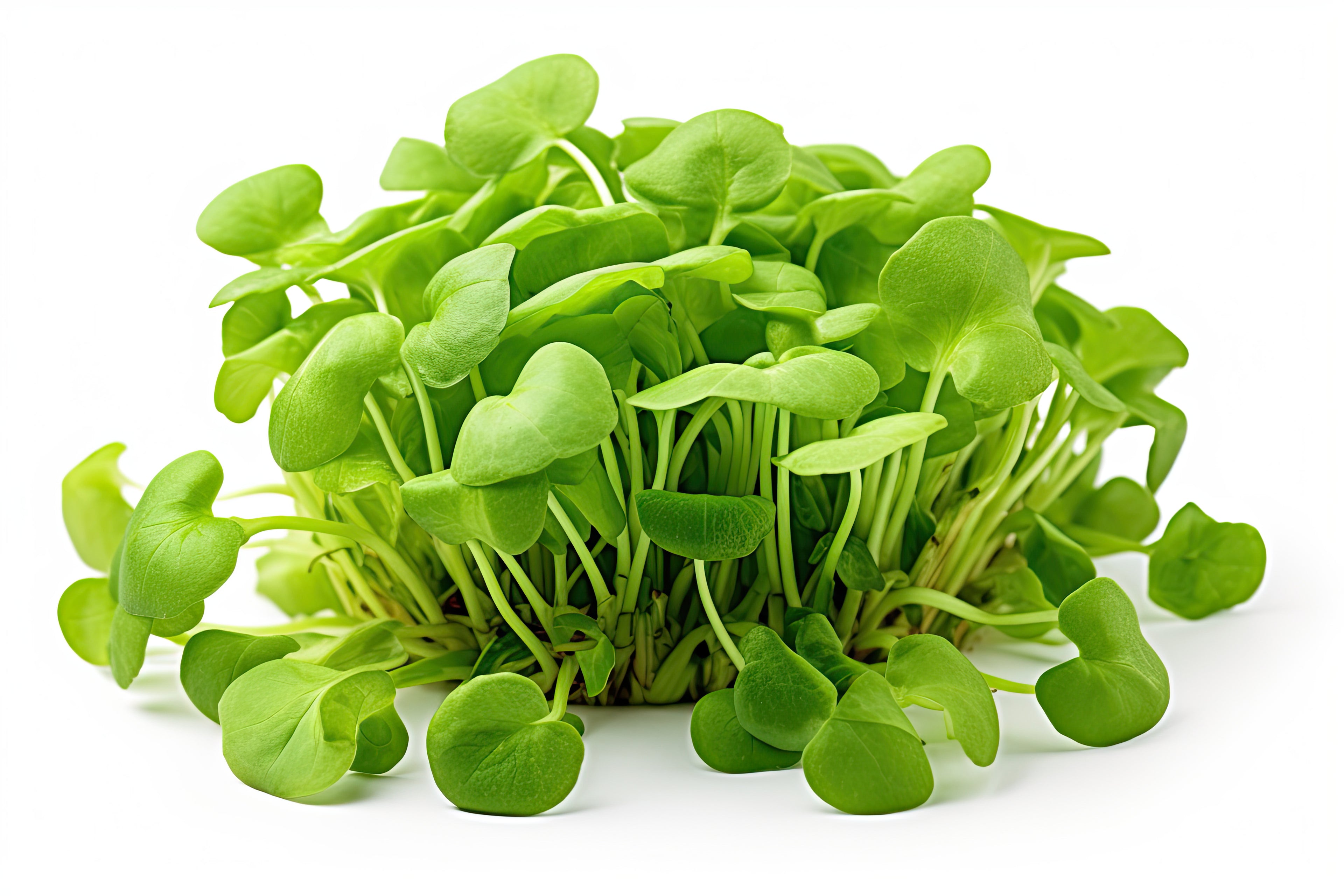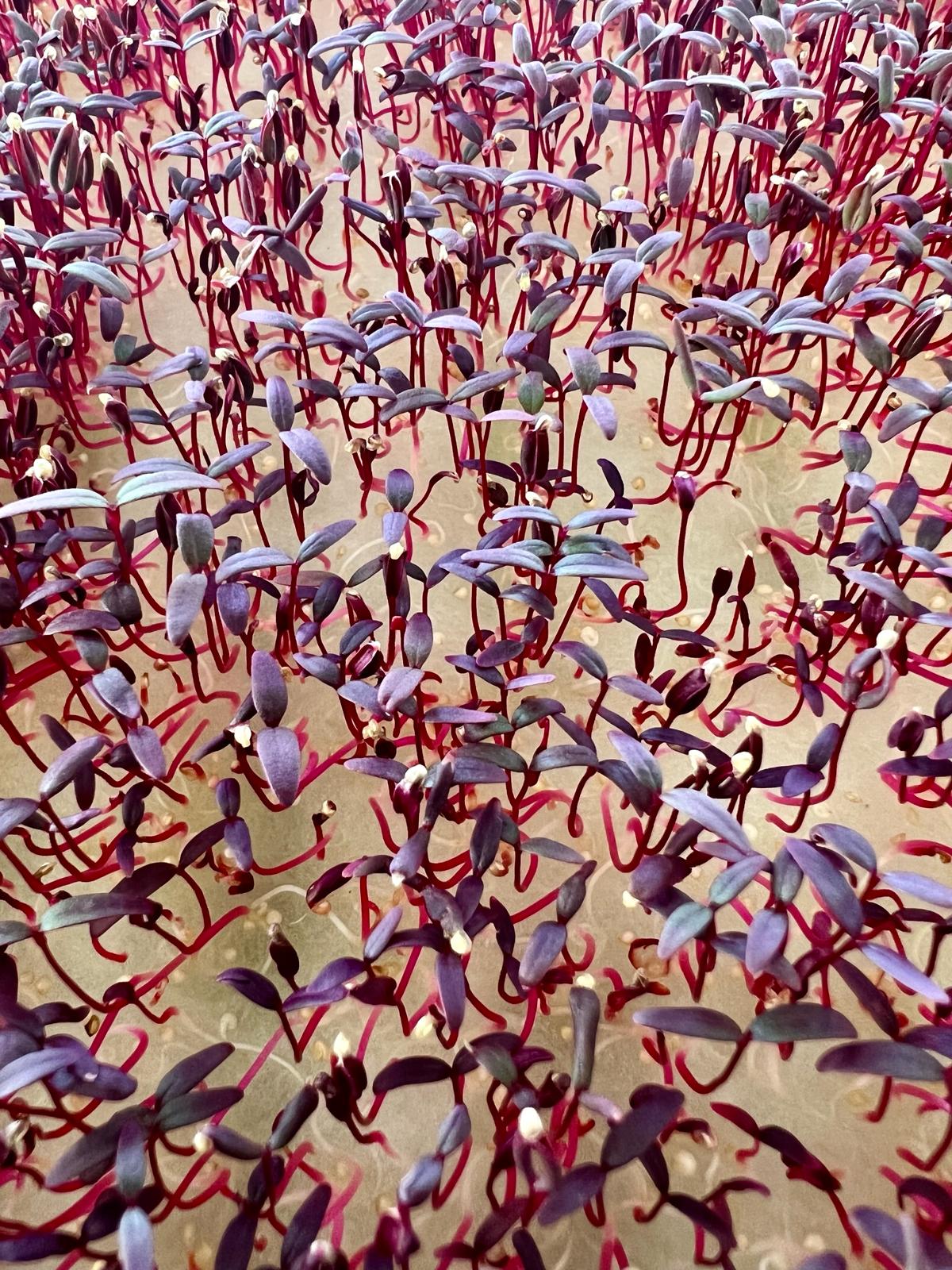
Growing microgreens at home: instructions & tips
03/08/2024 - pia from greeny+
The emerging trend from the USA is also becoming increasingly popular here. Microgreens are a nutrient-rich superfood that you can easily grow at home. Discover in our guide on the topic of “microgreens” how you can grow freshly harvested, vitamin-rich leafy greens on your windowsill within just a few days and enrich your diet.
-
The essentials in brief:
- Microgreens are nutrient-rich plant seedlings that are known for their high content of proteins, vitamins and trace elements and can be easily grown on the windowsill.
- Unlike sprouts, microgreens develop small green leaves and are eaten without their roots. They offer a variety of health benefits and have high concentrations of important vitamins.
- Growing microgreens at home is cost-effective and environmentally friendly.
What are microgreens?
Microgreens (also called microgreens, green cabbage or leafy greens) are the tender seedlings of vegetable and herb plants that are only a few days old and are still considered a superfood .
The term “Micro” refers to their small size when harvested, while “Greens” describes a variety of vegetable plants and herbs suitable for this particular cultivation.
All the energy for growth is concentrated in them, making them particularly rich in proteins, trace elements and vitamins .
Unlike sprouts, which are eaten with their roots, microgreens grow a little longer and develop juicy green leaves that are eaten without roots.
Microgreens are usually in a developmental stage between seedlings and adult plants . They are harvested when they are just a few centimeters tall and have already developed their first leaves.
During this phase they have already moved beyond the stage of pure germination, but are not yet fully grown like typical vegetable or herb plants.
- Seedling: Refers to the very first stage of microgreen development, when the seed has just germinated and the plant begins to develop roots and first leaves.
- Seedlings: Describes microgreens in a more advanced stage of development, where they have already developed several leaves but are not yet fully grown.
Growing microgreens is straightforward and requires little space, making them ideal for growing on windowsills or in small gardens. So they can be grown all year round . Despite their small size, microgreens offer high nutrient density and a variety of flavors, colors and textures.
Sprouts and microgreens: what's the difference?
In comparison to sprouts, which grow without a substrate and are eaten whole, including the roots, microgreens have already developed small leaves and are cut off on the surface of the substrate . While sprouts sprout in the dark when there is moisture, microgreens prefer light and air for their development.

Why is growing microgreens worth it?
Microgreens, the tender seedlings of vegetable and herb plants, offer an abundance of vitamins, minerals and enzymes - often in higher concentrations than full-grown vegetables .
These young plants are real energy bombs that contain everything the plant needs for its growth, including vitamins A, B6, C and a variety of trace elements . With their rich nutritional content, they are rightly called a superfood that promotes health.
The content of vitamins such as B1 and B2 in microgreens is particularly impressive, which is often more than three times higher than in full-grown plants . Despite their small size, microgreens are nutritional powerhouses that contain enormous amounts of vitamins during their growth phase.
Thanks to special cultivation techniques , growing microgreens is easy and requires little space . - Seed pads are a practical option for cultivation as the seeds are already prepared and no additional soil is required.
Microgreens are extremely versatile in the kitchen. They add an extra layer of flavor to salads, a crunchy texture to sandwiches, an aromatic note to soups and even a nutritional boost to smoothies.
However, it is important to consume microgreens raw to preserve their valuable nutrients . Cooking could cause some of the vitamins and minerals to be lost. Microgreens are therefore particularly suitable for raw or lightly cooked dishes in order to develop their full effect.
Advantages at a glance
High nutrient density
Microgreens contain concentrated amounts of vitamins, minerals and enzymes.
Easy cultivation
They can be easily grown at home in a small space, even without a garden.
Rapid growth
Microgreens germinate quickly and are ready to harvest in just a few days.
Health Benefits
Regular consumption of microgreens can help strengthen the immune system and promote overall health.
Cost efficiency
Compared to buying them in the store, home-grown microgreens can be more cost-effective and easy on the wallet.
Freshness and quality
By growing your own, you can control and ensure the freshness and quality of your food.
sustainability
Growing microgreens at home reduces the need for transportation and packaging, resulting in a lower environmental impact.
Variety of flavors
Microgreens offer a variety of flavors and textures that can enhance your dishes.
Versatile use
They can be used in a variety of dishes to enhance flavor and nutrients.
Which microgreens are there?
There is an impressive variety of microgreens you can grow at home. The selection of microgreen varieties depends on personal preferences and culinary needs.
Feel free to experiment a little and discover your own favorite microgreens!
Here are some examples:
-
- Broccoli : Mild, slightly sweet taste, rich in antioxidants, vitamins and minerals
- Radishes : Hot, tangy flavor, similar to full-grown radishes, are rich in vitamin C and other nutrients
- Cress : Hot, spicy flavor, are particularly popular as a garnish for salads, soups and sandwiches
- Mustard : Spicy, pungent taste, are a good source of various nutrients such as calcium, iron and vitamin C
- Beetroot : Mild, earthy taste, rich in antioxidants, vitamins and minerals
-
Spinach : Mild, slightly sweet flavor, rich in iron, calcium and other nutrients
- Coriander : Intense, spicy flavor, is a popular ingredient in many Asian dishes
- Basil : Intense, aromatic taste, are ideal as a garnish for pasta, pizza and salads
- Celery : Mild, tangy taste, rich in vitamins, minerals and antioxidants
- Lemon Balm : Lemony flavor, are a refreshing addition to salads, drinks and desserts
- Rocket, also known as arugula: Intense flavor reminiscent of pepper, are a popular choice for salads, sandwiches and other dishes
- Broccoli : Mild, slightly sweet taste, rich in antioxidants, vitamins and minerals
What are microgreens grown from?
Microgreens are grown from the seeds of various vegetable and herb plants .
These include, for example, radishes, broccoli, cress, rocket, mustard, spinach, basil and many more. The seeds are grown on special growing substrates such as organic soil or coconut fiber mats, which provide an optimal basis for the microgreens to germinate and grow.
These growing methods allow the microgreens to germinate quickly and concentrate their nutrients before they are harvested.
For a healthy harvest, the use of organic seeds is recommended - organic seeds are relatively uncontaminated by chemical pesticides and artificial fertilizers.
How can I grow microgreens?
Successful cultivation of microgreens basically requires the correct preparation of the seeds and appropriate care during germination .
However, growing it at home is easier than expected. All you need is a seed tray that you can either fill with soil (3-4 cm high) or line with several layers of kitchen paper, for example.
For seed trays, you can use everyday household items such as old casserole dishes, flower pot saucers or recycled plastic packaging for fruit or vegetables.
After sowing, the seed trays should be covered to increase the humidity and allow the seeds to germinate optimally. The optimal germination temperature for microgreens is between 15 and 22 °C , which makes growing them in living spaces easier.
Watering plays a crucial role in the growth of your microgreens - they require a consistently moist environment and should be watered approximately every 1-2 days.
-
Tip:
-
For beginners, sunflower and rocket microgreens are recommended to start with. These varieties are easy to grow and grow quickly.
- When preparing seeds, large and hard-shelled seeds such as those of peas or sunflowers should be soaked before sowing to speed germination. Soaking such seeds in water for a night or 24 hours helps soften the hard seed coat.
- As a complement to anyone striving for a healthy diet, the greenyGARDEN HOME from greeny+ offers a practical solution for growing herbs and leafy vegetables indoors. By using this innovative indoor garden, you can further develop your green thumb and enjoy a diverse selection of fresh, home-grown ingredients for a healthy diet.
-
For beginners, sunflower and rocket microgreens are recommended to start with. These varieties are easy to grow and grow quickly.

Caring for and harvesting microgreens
1. During the germination phase, plants should be kept in a warm and bright environment.
2. Moisture should be kept constant without flooding the seeds.
3. Too much moisture can promote mold, so balanced watering is crucial.
The microgreens are harvested as soon as the cotyledons and, in some cases, the first pairs of real leaves have formed. They should be cut about a finger's width above the substrate.
Make sure to only harvest as much as you need immediately, as the microgreens quickly begin to rot and must be processed immediately .
Conclusion
In summary, microgreens offer an excellent way to grow healthy and nutrient-dense food right in your own home . Thanks to her simple growing techniques and low maintenance requirements, even beginners can easily achieve success.
Also interesting:
View all-
Smart Garden – Die Zukunft mit Hydroponik
Einführung in das Konzept Smart Garden Was ist ein Smart Garden? Ein Smart Garden kombiniert innovative Technologien mit Gartenbau. Das Ziel sind optimale Bedingungen für das Pflanzenwachstum bei automatischer Steuerung....
Smart Garden – Die Zukunft mit Hydroponik
Einführung in das Konzept Smart Garden Was ist ein Smart Garden? Ein Smart Garden kombiniert innovative Technologien mit Gartenbau. Das Ziel sind optimale Bedingungen für das Pflanzenwachstum bei automatischer Steuerung....
-
Hydroponik mit Drip-Systemen einfach erklärt
Du möchtest nachhaltig und effizient gärtnern, aber möglichst wenig Aufwand haben? Dann könnte das hydroponische Drip-System (Tröpfchenbewässerung) genau richtig für dich sein. In diesem Artikel erfährst du mehr übers Drip-System. ...
Hydroponik mit Drip-Systemen einfach erklärt
Du möchtest nachhaltig und effizient gärtnern, aber möglichst wenig Aufwand haben? Dann könnte das hydroponische Drip-System (Tröpfchenbewässerung) genau richtig für dich sein. In diesem Artikel erfährst du mehr übers Drip-System. ...
-
Entdecke das DFT-System (Deep Flow Technique) -...
Was unter der Bezeichnung Hydroponik bekannt ist, eröffnet Dir eine spannende Welt, in der Pflanzen ohne Erde gedeihen – nachhaltig, effizient und platzsparend. Das sogenannte DFT-System (Deep Flow Technique) ist eine...
Entdecke das DFT-System (Deep Flow Technique) -...
Was unter der Bezeichnung Hydroponik bekannt ist, eröffnet Dir eine spannende Welt, in der Pflanzen ohne Erde gedeihen – nachhaltig, effizient und platzsparend. Das sogenannte DFT-System (Deep Flow Technique) ist eine...
1
/
of
3

